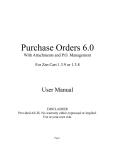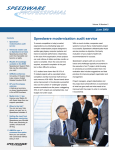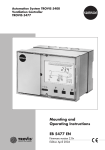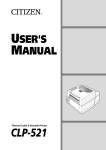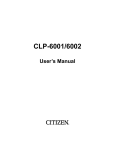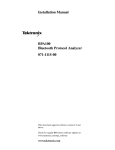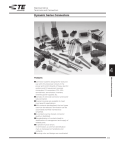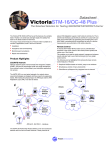Download Application Series ATM Testing with the SunSet OCx or SunSet SDH
Transcript
… a step ahead Application Series ATM Testing with the SunSet OCx or SunSet SDH 302 Enzo Drive San Jose CA 95138 USA ph 1 408 363 8000 fax 1 408 363 8313 [email protected] www.sunrisetelecom.com Publication Number APP-OPT-002 Rev. A 2 INTRODUCTION Asynchronous Transfer Mode (ATM) is the most widely deployed backbone technology in the world. ATM grew out of a need to provide a variety of broadband digital services over a wide area network (WAN). Today, ATM carries voice, data, video, and Internet Protocol (IP) traffic and is the predominant technology for DSL networks. Unique among all technologies, ATM guarantees a predefined quality of service (QoS). With its emphasis on reliability and QoS, ATM requires extensive testing when installing and turning up connections. Once up, ATM networks are typically very robust and stable, especially those running on a SONET/SDH backbone, but periodic monitoring of ATM traffic and performance is required to ensure the network is running smoothly. The test procedures described herein address physical layer testing, QoS and BER testing, IP-layer testing, and network monitoring. QoS, BER, and IP testing are most appropriate for out-of-service testing, such as when installing an ATM network or when troubleshooting a network that has failed. Network monitoring is applicable for live or test traffic. ATM provides two layers for addressing and switching based on a Virtual Path Indicator (VPI) and Virtual Channel Indicator (VCI). In a Virtual Path Connection (VPC), all ATM cells sharing the same VPI addresses share the same connection. Within a VPC, the user can choose between thousands of channels by designating the VCI of the ATM cell. A Virtual Channel Connection (VCC), on the other hand, is defined by a VPI/VCI pair and only applies to that single channel. In Permanent Virtual Circuits (PVC), connections are assigned with fixed VPI/VCI values. In a Switched Virtual Circuits (SVC), VPI/VCI values are reassigned after every call. The signaling and routing used for SVC circuits is not addressed in this application note. VPI/VCI values only have local significance—the VPI/VCI values are likely to change at each ATM switch. Cells that start with VPI/VCI of 0/32 may be changed to 8/45, for example. This presents a challenge to ATM testing— some knowledge of the routing tables is required to properly track specific cells at any part in the network. ATM Cells ATM uses small, fixed-length cells to facilitate fast switching through a network. Each cell consists of 5 bytes of header plus 48 bytes of payload. BACKGROUND Header: 5 octets ATM is a connection-orientated technology. The route through the network is defined before any user data is sent. In this way, the ATM network can be held to stringent quality of service and traffic parameters. The goal of ATM testing is to quantify the quality of the connection at the physical layer, ATM layer, and higherlayer applications such as IP, whether installing a new connection or monitoring a live network. ATM Connections ATM is defined across an array of physical carriers including SONET/SDH and T-Carrier/ PDH. The SunSet OCx and SunSet SDH supports ATM testing from 1.5 Mbps (T1) and 2 Mbps (E1) up to 2.5 Gbps (OC-48, STM-16). The terminology and testing procedures for ATM are independent of the physical layer— only the maximum cell rates differ. The ATM Cell header contains the VPI, VCI, Payload Type Indicator (PTI), Cell Loss Priority (CLP), and Header Error Control (HEC) byte. UNI cells also include a field for Generic Flow Control (GFC). The GFC only has local significance and is not carried end-to-end. In most testing applications, the GFC can be ignored and simply set to zero. User-Network Interface (UNI) Header GFC ATM defines two types of interfaces: User-toNetwork Interface (UNI) and Network-toNetwork Interface (NNI). NNI applies to traffic between ATM switches and UNI describes the traffic between an edge device and an ATM switch. Aside from a slight difference in their headers (see figure to the right), they are identical for testing purposes. © 2001 Sunrise Telecom Incorporated Payload: 48 octets VPI VCI PTI CLP HEC Network-Network Interface (NNI) Header VCI values from 0 to 31 are used for ATM-layer alarms, network messaging, and other reserved uses. Though the VCI can be as high as 65,535, not all ATM switches ATM Testing with the SunSet OCx or Sunset SDH 3 support all VCI values. When testing ATM networks, VCI values from 32 to 1023 are best. Header Field Recommended Value(s) GFC 0000 (binary) VPI 0 to 255 once a second, well below the typical bandwidth of user cells. Alarm Indication Signal (AIS) and Remote Defect Indicator (RDI) cells are two types of Fault Management (FM) OAM cells. ATM-layer AIS and RDI defects have similar definitions to their SONET and SDH counterparts. VCI 32 to 1023 So long as the VCI value is 32 or higher, PTI 000 (binary) any VPI value can be CLP 0 used. While NNI can have a VPI up to HEC Set Automatically 4094, UNI can only support VPI values up to 255. Therefore, it is recommended to use VPI of 255 or less. OAM cells are designated as F4 (VPC) or F5 (VCC). OAM cells can also apply to a single segment in the network or end-to-end. F4 OAM cells are distributed to all VCIs sharing the same VPI. F5 OAM cells are only delivered to the specific VPI/VCI indicated. A VCI of 3 (segment) or 4 (end-to-end) indicates an F4 OAM cell. A PTI of 100 (segment) or 101 (end-to-end) indicates an F5 OAM cell; F5 OAM cells have a normal VCI value. The PTI is used to indicate alarms and traffic congestion. PTI values of 000 or 001 are best for most testing applications. Advanced users may wish to manually indicate congestion by setting the PTI to 010 or 011 and see if the cells are dropped. When generating OAM cells from your SunSet, use the ATM Alarm generation function of the set. Do not create a VCC and manually set the VCI or PTI value to indicate an OAM cell. OAM cells contain special information fields that are not included in a user cell payload. When the CLP bit is set to 1, the cell has a higher probability to be dropped by a switch. While useful for stress testing, it may not accurately reflect live traffic; therefore, setting CLP to zero is recommended. OAM Type Value Fault Management 0001 Performance Management Function Type Usage AIS Alarm Indication Signal Value 0000 RDI Remote Defect Identification 0001 Continuity Check Continuous monitoring of connections 0100 Cell Loopback Check connection continuity 1000 Forward Monitoring On-line performance assessment 0000 Backward Monitoring On-line performance assessment 0001 Performance Monitoring Performance Monitoring 0000 Continuity Check Continuity Check 0001 Group Group APS 0000 0010 Activation and Decativation 1000 ATM Protective Switching 0101 Individual APS 0001 Individual The HEC byte provides protection against bit errors in the cell address field and provides a mechanism to delineate cells from the physical layer. O.191 Test Cell HEC provides no protection for the ATM cell payload. A ITU-T specification O.191 defines a special cell to test CRC algorithm generates the HEC value based on the the QoS of an ATM connection. The O.191 test cell preceding bytes in the header. This algorithm can contains a sequence number, timestamp, and CRC field, correct a single bit error within the 5-byte header; thus, but no test pattern with which to make a BER measurethese are called correctable HEC errors. A non-correctment. For BER testing, create a user cell with a pseudoable HEC error consists of two or more bit errors in the random pattern, such as 215-1 (2e15). address. OAM Cells Operation, Administration, and Maintenance (OAM) cells provide alarms, continuity checks, performance reports, protection switching, and other messages for the ATM network. OAM cells are typically only sent 5 octets 4 bits Header OAM Type 4 bits Function Type 45 octets Function Specific Field © 2001 Sunrise Telecom Incorporated 6 bits Future Use 5 octets Header 4 bytes Sequence Number 4 bytes 37 bytes Timestamp 1 byte 2 bytes TCPT Unused CRC-16 10 bits Error Detection Code ATM Testing with the SunSet OCx or Sunset SDH 4 COMMON TESTING PITFALLS ATM Scrambling To prevent the ATM payload from resembling the SONET/SDH framing bytes (A1, A2), the ATM payload can be scrambled. Most switches have scrambling enabled by default. Scrambling does not affect the cell header and will not impact the ability of a test set or switch to detect ATM cells. However, user data sent across an ATM connection with a scrambling mismatch will become incoherent and useless. Basic network monitoring is not affected by scrambling, but other ATM tests, including QoS, BER, and IP testing, will not function properly. If you are able to receive ATM cells but unable to make a QoS or BER measurement, double-check the scrambling setting on both the ATM equipment and your SunSet. The SunSet’s scrambling setting is in the ATM Setup or Configuration Menu. SUNSET SETUP For a more detailed description of the functions, options, and measurements of your SunSet, refer to the User’s Manual. Configure the test set 1. On the SunSet OCx OC-48 platform or the SunSet SDH, set the Test Mode to ATM. Then set the Interface and Payload rates to match the network being tested. 2. On the SunSet OCx OC-12/3 platform, set the Test Mode to PT-PT and set the Interface and Payload rates to match the network being tested. Then, go to the ATM functions menu to begin transmitting and receiving ATM cells. 45 Mbps ATM Mapping Two methods of mapping ATM cells into a 45 Mbps (DS3) signal are utilized by switches. Physical Layer Convergence Protocol (PLCP) defined in IEEE 802.6 and ITU-T G.804 maps the ATM cells into a SONET-like frame inside the 45 Mbps signal. HEC-based mapping, also defined in G.804, places the ATM cells directly into the 45 Mbps signal, equivalent to the way ATM cells are mapped into SONET/SDH. If the mapping of the test set does not match the mapping used by the ATM switch, the test set will not recognize any ATM cells from the switch, and vice-aversa. To change your ATM mapping, go to the ATM Setup or ATM Configuration menu. Payload Label Mismatch (PLM) SONET and SDH specifications indicate that ATM traffic should use a Payload Label (C2 byte in the path overhead) of 13 (hex). However, not all switches use this label and the SunSet OCx (OC-12/3) will not send 13 until you enter ATM Functions. When the C2 bytes do not match, a PLM-P alarm is declared. The PLM does not interfere with physical layer measurements, but may prevent an ATM switch from detecting ATM cells. To prevent a switch from getting a PLM, you can also change the C2 byte transmitted from your SunSet. Go to the Send POH Bytes menu within SONET or SDH Features. Your SunSet will transmit and receive ATM cells properly despite a PLM. On your SunSet OCx, you can disable the PLM measurement or you can change the expected C2 value by going to your Measurement Configuration menu. © 2001 Sunrise Telecom Incorporated Connect the test set 1. When monitoring a live circuit, be sure to use a monitor jack, such as on a DSX panel. Optical networks should have a splitter, such as 90/10, that passes 90% of the signal through to the network and allows a test set to access the 10% signal nonintrusively. When monitoring only, do not connect the transmit jack of the test set. 2. When connecting to a multimode system, use multimode cables. The receiver on your SunSet OCx/ OC-48 may not be multimode compatible, depending on which configuration was ordered. Verify with Sunrise Telecom customer service. 3. If you see a Loss of Signal (LOS) or Loss of Framing (LOF) when connecting optical equipment, a highpowered transmitter that is saturating the receivers may be causing it. This is especially true when connecting the SunSet’s single mode lasers to a multimode system. In these situations, add an attenuator, typically -10 dB is adequate. ATM Testing with the SunSet OCx or Sunset SDH 5 Physical Layer Testing 1. The first step to installing or monitoring any ATM network is verifying that the physical layer is free of problems. Errors and defects on the physical layer are a major cause of problems that affect ATM traffic. 2. When you connect the SunSet, you should get green LEDs for the selected interface and framing. If the PULSES or rate LEDs are green but the FRAME LED is not, verify that the interface you are connected to matches the Test Configuration. 3. You should also see the ATM CELL LED light green to indicate the presence of ATM cells. If the ATM CELL LED is off, the test set has not been configured for ATM testing. If you are using a SunSet OCx (OC-12), you must first go to the ATM Functions menu for the ATM CELL LED to activate. If you are testing a 45 Mbps or DS3 circuit, verify that you have the proper ATM mapping. 4. If the LEDs are flashing red, press the HISTORY or LED key to clear the history condition. Once you are satisfied that the LEDs indicate no errors or alarms, (re)start the measurement to clear away any errors that were detected during setup. 5. Go to the Measurement Results screen. You should see "NO ERRORS" or "NO ERR" displayed on the summary screen. ATM NETWORK MONITORING When an ATM network is up and running, use the test set to monitor the ATM cells on the network. Review the procedure above for connecting the test set to the circuit. The test set can monitor the network continuously or be programmed to run a test during the peak usage times. The latter frees a technician from having to personally monitor the test. The test set can monitor for a specific length of time, such as 15 minutes or 5 hours, to get a snapshot of the network performance. 4. On the SunSet OCx/OC-48 or SDH, the VCC Scan screen also shows the utilized or available bandwidth, as selected in the VCC Scan Configuration screen. In addition, the unit can filter on a specific VPI value, allowing you to concentrate on a single VPC. 5. If no traffic appears in the scan and the ATM CELL LED is green, the circuit may be filled with idle or unassigned cells. Go to VCC Scan Configuration and set the VPI Capture field to "ALL" to prevent the desired VPI from being filtered. 6. If some traffic appears, but important VPI/VCI values are missing, move the monitoring point closer to the source, switch by switch, until the cells appear. Traffic can disappear because network bottlenecks force switches to drop cells or because a switch has been configured incorrectly and is sending cells down the wrong port. The PTI and CLP fields in the header indicate when ATM connections are experiencing congestion or potential cell loss. 7. If "mystery" VPI/VCI values appear on the traffic scan, a misconfigured switch may be sending cells with incorrect VPI/VCI. Detailed Traffic Analysis This process monitors a specific VCC for bandwidth problems, errors, and alarms. 1. Select a specific VPI/VCI from the ATM traffic scan to be analyzed. Do this by selecting SAVEVCC or SAVE RX while highlighting the desired VPI/VCI. 2. Go to VCC Statistics and find the VPI/VCI just saved. Press Detail to see the detailed statistics. Note the Cell Count and Cell Rate and verify they match the specified parameters. PVCs and SVCs have predefined maximum and minimum allowable cell rates. Cells that exceed the limits will be given a CLP of 1 and may be dropped. The test set shows the number of these tagged cells. ATM Traffic Scan 1. Use the VCC Scan feature to observe all the channels currently used in that section of the network. This process helps identify missing VCCs, monitors total utilized bandwidth, and can identify misconfigured switches. Beware that the VPI/VCI value of a VCC will change at each switch, so knowledge of the proper VPI/VCI values is vital to properly interpreting the results. 2. After connecting to the circuit, go to the ATM/IP or ATM Functions menu & select the VCC Scan feature. 3. The header values are sorted by when they were detected. The example also shows how a change in the GFC, PTI, or CLP bits for a single VCC will result in two (or more) entries. © 2001 Sunrise Telecom Incorporated ATM Testing with the SunSet OCx or Sunset SDH 6 3. Congestion is indicative of bandwidth limitations and may result in cells dropping. To assure good QoS, monitor the congested cell rate. If too many cells are congested or tagged, cell loss may occur. By moving to different switches, you can identify network bottlenecks and increase bandwidth accordingly. 4. Verify that the call control settings are correct and that the source of the ATM traffic is not exceeding this limit. Cells rates below the minimum are very disruptive to the services, like video and voice, being carried over the ATM network. In the case of Constant Bit Rate (CBR) traffic, it is vital that the rate is a constant value and never drops or bursts. 5. HEC errors in an ATM system indicate that bit errors are occurring on the physical layer. Non-correctable HEC errors result in dropped cells and an increased cell loss ratio (CLR). The customer’s ATM service contract will specify maximum CLR and HEC error rate. 6. You can also see any alarms, such as AIS or RDI, on the VCC. An AIS is a very serious problem, indicating a complete lack of service on the VPC (F4) or VCC (F5). An RDI is a far-end response to an AIS; when you see an RDI, there is an AIS occurring in the channel’s opposite direction. Typically, an AIS is due to an LOS, LOF, or Loss of Pointer (LOP) on the physical layer. OUT-OF-SERVICE TESTING The goals of this step are to insert ATM cells, verify that they are received with no errors, and to test the bandwidth limitations of the network. The test set will insert ATM cells into the network and analyze them upon return. This type of test is typical when installing ATM switches or turning up a network, though it can also be used on an in-service network. The procedure below breaks down the test into several steps. In practice, these can be done simultaneously with the test set. Creating an ATM circuit 1. Before testing, the ATM network administrator must first establish a PVC through the network and specify which VPI/VCI are to be used for the test. When installing new ATM service, the VPI/VCI values will be the same as specified for the end customer. Otherwise, the administrator will create a PVC specifically for the test. If the network is also carrying live traffic, the bandwidth available for testing will be restricted. If the utilized bandwidth is already 80% or higher, the test may affect the QoS on the network as the available bandwidth decreases even further. © 2001 Sunrise Telecom Incorporated 2. Most tests use two test sets, one connected at each end of the PVC. The test can be unidirectional or bidirectional, but a PVC must be created for each direction under test. 3. When using a single test set, some type of loopback is required. A hard loopback uses a cable looped between the transmitter and receiver so that every transmitted cell comes back. Hard loopbacks should not be used for in-service testing and are most appropriate for testing a single ATM switch. An alternative method is to specify a PVC that sends the cells back in the direction of the test set. Because the PVC only applies to specific address values, this will not disrupt the network. VCC Setup Your Sunset can generate up to 6 or 8 VCCs, but in most cases, you only need to test one VCC at a time. The other 5 or 7 VCCs are used for background traffic, filling up the bandwidth of the connection. 1. Go to VCC Setup and select the first VCC. Input the VPI/VCI values for the VCC under test. You can set the received and transmitted header values independently. Again, VCI values 32 and higher are best and leave the PTI and CLP values 0 unless you want to simulate congested or tagged cells. 2. In the traffic field, select CBR for most applications. 3. For a new network, start transmitting cells at a 100% bandwidth. You can do this with a single VCC or a number of VCCs. If adding a VCC to a live network, the maximum bandwidth depends on the current utilization, which you can see on the VCC Scan screen on page 5. You can then measure the QoS or BER at each bandwidth. If you discover errors or poor QoS, incrementally reduce the bandwidth until the QoS and BER are within acceptable parameters. 4. As your payload, select Pattern for BER testing or Test Cell for QoS testing. On the SunSet OC-12/3 or STM-1 black-and-white unit, there is no option for Test Cell. Instead, select the ALL 0 pattern & activate the timestamp and sequence number. This is similar to an O.191 test cell, but lacks the CRC field. For BER testing, set your pattern to a pseudo-random bit stream (PRBS) pattern like 223-1, 220-1, or 215-1. 5. Be sure the transmitted and received VCCs are activated and both the transmitter and receiver are properly connected to the switch. When you begin the test, you should have a green ATM CELL LED. If not, see Physical Layer Testing, above. If problems occur during QoS and BER testing, verify that both test sets are set to the same pattern, both have proper scrambling setting, and they have the same pattern truncate setting (ATM Setup). In BER testing, the SunSet should show pattern synchronization with a green PAT SYNC LED. ATM Testing with the SunSet OCx or Sunset SDH 7 QoS Testing The key parameters for QoS testing are Errored Cells and Cell Error Ratio (CER), Lost Cells and Cell Loss Ratio (CLR), and Misinserted Cells and Cell Misinsertion Rate (CMR). Ideally, all these values will be zero. 1. If the CLR is above zero, it may be due to cells being tagged for not complying with present bandwidth parameters. 2. Also check the CLR of cells with a CLP of 1. BER Testing 1. Verify that the test set receives the cells free of bit errors. Inject a burst of one or more bit errors and verify the same number of bit errors is received. 2. Inject a specific BER, such as 1x10-6 (one errored bit error per million); the test set should receive the same BER without any added bit errors. OAM Cells These tests are most appropriate during installation to verify proper handling of OAM cells and verify that the contents of the OAM cells are correct. 1. On the SunSet OCx/OC-48 or SDH, send OAM cells from the Alarm/Errors menu. On the SunSet OC-12/3 or black-and-white SDH, you must be in the detailed VCC statistics screen to inject OAM cells. 2. To view the contents of a cell, go to Cell Capture. To avoid capturing user cells, set the cell type to OAM in the configuration screen. The SunSet will decode the header and OAM fields, as applicable, of the captured cells—simply select the Header or OAM F-keys. Warning: Sending OAM cells may affect other traffic on the network. 3. Insert an OAM cell, such as a VP AIS or VC RDI, and verify that the network element measures and reacts accordingly. When an ATM switch receives a VP AIS, it should send a VC AIS downstream and an VP RDI upstream. 4. Inject a VP or VC loopback cell and verify that the switch loops it back. Instruct the switch to send a Performance Management (PM) OAM cell. COMMON ACRONYMS AAL AIS ATM APS BER CER CLP CLR CDV CMR CRC CTD DSL DSX EDC FM GFC HEC IP LCD LED LOC LOF LOP LOS UNI NNI OAM PLM PRBS PM PTI PVC QoS RDI SDH SONET SVC TCPT VCC VCI VPC VPI WAN ATM Adaptation Layer Alarm Indication Signal Asynchronous Transfer Mode Automatic Protection Switching Bit Error Rate Cell Error Ratio Cell Loss Priority Cell Loss Ratio Cell Delay Variation Cell Misinsertion Rate Cyclic Redundancy Check Cell Transit Delay Digital Subscriber Loop Digital Signal Cross Connect Error Detection Code Fault Management Generic Flow Control Header Error Control Internet Protocol Loss of Cell Delineation Light Emitting Diode Loss of Cell Loss of Framing Loss of Pointer Loss of Signal User-to-Network Interface Network-to-Network Interface Operation, Administration, and Maintenance Payload Label Mismatch Pseudo-Random Bit Stream Performance Management Payload Type Indicator Permanent Virtual Circuit Quality of Service Remote Defect Indication Synchronous Digital Hierarchy Synchronous Optical Network. Switched Virtual Circuit Test Cell Payload Type Virtual Channel Connection Virtual Channel Indicator Virtual Path Connection Virtual Path Indicator Wide Area Network Refer to Publication GL-001 for a more extensive list of ATM terms. © 2001 Sunrise Telecom Incorporated ATM Testing with the SunSet OCx or Sunset SDH … a step ahead








